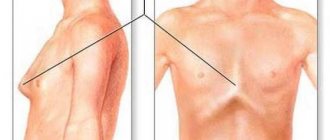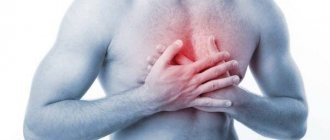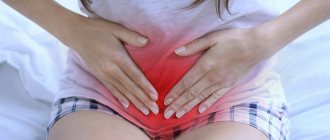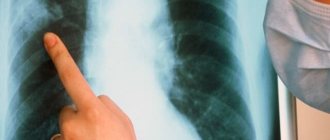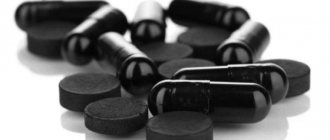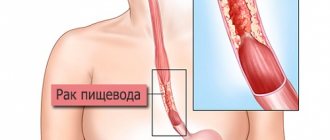Belching air is a physiological process that occurs occasionally in all people. It is caused by gases accumulating in the stomach. They can form due to overeating, drinking a lot of soda, and swallowing air while eating. But if belching air becomes regular and is accompanied by pain in the chest, this indicates a disturbance in the functioning of the digestive system and the need to consult a specialist.
Chest pain when belching is a serious reason to see a doctor.
Causes
Vital organs such as the heart, lungs, esophagus and nerve plexuses are concentrated in the chest area, so pain in the chest during belching can signal a problem in any of them.
- If frequent belching is accompanied by pain in the middle of the chest, this is due to malfunctions of the digestive system.
- If after burping the patient has difficulty breathing and a coughing attack begins, then problems with the respiratory system can be suspected.
- The pain in the left side of the chest that accompanies belching, the echoes of which are heard in the left arm and back, are typical for diseases of the cardiac spectrum.
- Belching that occurs against a strong emotional background, along with which patients note difficulty in breathing painfully and a feeling of a lump in the chest, can be caused by neuralgia.
Malfunctions of the digestive organs directly depend on the state of the nervous system. A calm emotional background is a prerequisite for the full functioning of the gastrointestinal tract.
The most common pathologies and conditions that cause pain in the chest together with belching:
The hydrochloric acid present in the stomach irritates the esophageal mucosa, causing heartburn and belching, which has a sour taste and may contain pieces of food. As a result of constant contact of the mucous membrane with the acidic environment in the esophagus, signs of developing inflammation are diagnosed, which causes a burning sensation in the middle of the sternum during belching.
Gastro-food reflux leads to a number of complications caused by the acidic environment in the larynx and oral cavity: destruction of tooth enamel, chronic tonsillitis, ulceration of the esophageal mucosa. If the disease is not diagnosed and treated promptly, it can lead to narrowing of the esophagus. A decrease in the lumen develops gradually as coarse connective fibers form instead of elastic tissues. The narrowing prevents the normal passage of food and causes pain in the chest with every meal, the pain syndrome is especially pronounced when eating solid foods.
The part of the stomach adjacent to the esophagus is called the cardia. During eating, it rhythmically contracts and relaxes, opening the lumen for incoming food. In patients with this pathology, during swallowing, the muscle tone of the sphincter does not decrease, preventing the normal passage of food into the stomach. Characteristic symptoms of the disease include belching, chest pain, difficulty swallowing and moving food through the esophagus. The disease is inextricably linked with the state of the nervous system, worsens against the background of stress and is accompanied by symptoms of vegetative-vascular dystonia: tachycardia, sweating, spasms during breathing.
We recommend watching the video: 3 tests for chest pain. How to find out what hurts behind the sternum
This name is given to a bag-like protrusion of the wall, which occurs due to a violation of the integrity of the muscle layer. The disease causes pain in the chest when belching. The intensity of symptoms depends on the size, number and location of diverticula in the esophagus. Symptoms appear after food debris gets into the diverticula. While in the bag, they rot, irritate the mucous membranes, cause heartburn and belching with a putrid taste.
Therapy for nervous disorders
Lump in the throat (causes and treatment are related) from psycho-emotional disorders. Treatment begins with identifying the causes that provoke the “nervous lump” - stress, periodic panic attacks, frequent hysteria. Increased stress on the nervous system leads to spasm of the pharyngeal muscles, leading to the symptom of a lump.
Treatment is carried out using:
- Antidepressants (Moclobemide, Tryptozol, Ludiomil).
- Nootropic drugs (Piracetam, Nootropil, Cinnarizine).
- Neuroleptics (Teralen, Aminosin, Majeplit).
- Psychostimulants (Pantogam, Zoloft, Omaron).
Dosages and course duration must be observed to avoid addiction. A non-addictive drug that has proven itself well in the treatment of anxiety and mental instability is Afobazol. While taking the medicine, driving and performing work with concentration are not prohibited.
For minor nervous disorders, treatment with tinctures of sedative herbs is recommended, such as:
- motherwort;
- peppermint;
- valerian;
- peony;
- St. John's wort.
Treatment is prescribed when determining the disease that caused the formation of a lump in the throat.
If the patient suffers from gastrointestinal pathology, the gastroenterologist prescribes:
- diet;
- antacids that reduce stomach acidity (Phosphalugel, Rennie);
- inhibitors that help reduce the production of gastric acid (Omez, Pariet);
- drugs against vomiting, nausea (Passazhix, Metoclopramide);
- drugs for dysbacteriosis and flatulence (Hilak Forte, Linex);
- enzyme-containing - to facilitate the breakdown of food (Festal, Pancreatin);
- sorbents for removing toxins (Activated carbon, Smecta).
For endocrine pathologies, an endocrinologist prescribes:
- dietary adjustments with an increase in iodine-containing dishes;
- with reduced production of active substances (Triiodothyronine, Thyreocomb);
- reducing thyroid activity (Tyrozol, Thiamazol);
- antibiotics against tissue inflammation (Ciprofloxacin, Amoxicillin);
- laser therapy;
- magnetotherapy.
The treatment is long-term, requiring strict dosages to avoid complications and allergies.
To treat respiratory infections that cause a lump, the following are used:
- antibiotics (Amoxiclav, Cephalexin);
- non-steroidal drugs to relieve inflammation (Nise, Ibuprofen);
- immunostimulants (Echinacea, Cycloferon);
- antipyretic drugs (Aspirin, Panadol, Paracetamol);
- physiotherapeutic procedures (UHF, UV);
- inhalation;
- compresses;
- rubbing.
For the treatment of cervical osteochondrosis and vertebral syndrome, leading to discomfort in the Adam's apple area:
- taking antispasmodics (No-shpa, Spazgan);
- non-steroidal anti-inflammatory drugs (Ibuprofen, Diclofenac, Ortofen) in the form of tablets, injections, gels, ointments;
- warming gels (Finalgon, Revmalgon);
- physiotherapy (electrophoresis, acupuncture, magnetic therapy, massage).
If new growths in the form of tumors are detected, surgical intervention may be required.
Treatment
When a patient has a history of symptoms such as painful belching and chest pain, the gastroenterologist will conduct a thorough examination before deciding what to do to relieve them. The doctor’s goal is to find the underlying disease that causes belching and combat it using conservative or surgical methods. To relieve symptoms, antacid medications are prescribed to lower the acidity level of gastric juice.
All patients are prescribed a strict diet. You need to eat regularly in small portions. The following foods are excluded from the diet:
- hot dishes;
- rough and hard to chew food;
- fatty, smoked and fried foods;
- sour, spicy and pickled foods;
- legumes and cabbage;
- fatty dairy products;
- carbonated drinks;
- alcohol.
This diet reduces the frequency of air passages and helps reduce chest pain. Patients are also advised to quit smoking.
A strict diet is a must when treating painful belching.
If the attending physician gives permission, you can combine medications with traditional medicine. The influence of herbal infusions, decoctions, oils, and bee products stimulates digestion, reduces gas formation, and improves the condition of the mucous tissues of the digestive system. Such remedies as a decoction of oats and flax seeds, mumiyo, potato juice, sea buckthorn oil, etc. will help achieve a positive effect.
Burning sensation in the sternum - causes
This kind of syndrome mainly occurs when there is a disorder of the digestive system: increased stomach acidity, esophagitis, ulcers. However, there are other reasons that can trigger the appearance of an unpleasant symptom. Explaining why there is a burning sensation in the chest, doctors urge people suffering from cardiovascular diseases to be especially careful.
There are cases when patients mistook the symptoms of a heart attack and angina pectoris for banal severe heartburn. In this case, an extremely dangerous situation arises for the patient, which can lead to serious consequences, so you should not ignore even the most insignificant negative conditions at first glance. Meanwhile, doctors claim that patients have pain in their chests for the following general reasons:
- pathologies of the gastrointestinal tract;
- intercostal neuralgia;
- cardiovascular diseases;
- colds;
- emotional and mental disorders;
- tumor processes.
Burning in the left side of the chest
According to medicine, there may be a stove there due to many reasons. It may become hot due to dysfunction of the pancreas - with this pathology, the burning sensation is limited to the left hypochondrium. Inflammation of the duodenum also manifests itself with similar symptoms. A burning sensation in the chest on the left is also a symptom of a stomach ulcer or gastritis. Separately, it is worth mentioning such a pathology as acute pancreatitis - this disease is quite capable of triggering an intolerable syndrome and leading to peritonitis.
Hormonal imbalance in the weaker sex often manifests itself in negative conditions. Tingling and burning in the left sternum in women often indicate latently developing mastopathy of the mammary glands. Many ladies experience severe discomfort before menstrual bleeding, which is regarded as a completely natural condition. Women often experience a burning sensation in their chests due to hormonal changes. Ladies during menopause are especially sensitive to this kind of manifestation.
Belching with bile and bitterness
The most common symptom, which is accompanied by pain, is belching with bitterness and bile. There are many reasons for this phenomenon. They are usually associated with gastrointestinal disease, namely the gallbladder.
Basically, such belching appears in the following situations:
- Pregnancy. A woman’s uterus is enlarged and puts pressure on the duodenum. After this, the bile enters the stomach and then into the oral cavity. Very often pregnant women burp when they sleep.
- A malignant tumor, hernia, injury - all these abnormalities in the body are also the causes of bitter belching.
- Use of antispasmodic medications. Muscle relaxants cause the release of bile and bitterness along with belching.
- Surgical intervention. In this situation, the digestive process usually changes. Belching occurs, bile is thrown into the stomach.
Burning in the middle of the chest
Pathologies of the heart and blood vessels are often accompanied by unpleasant sensations. However, most patients do not realize that a burning sensation in the middle of the chest indicates the development of serious conditions. In a situation where the heat in the chest is not eliminated by drinking soda water, most likely we are talking about heart failure, the symptoms of which can be relieved by taking a Nitroglycerin tablet. Experts identify the following diseases that are accompanied by a burning sensation in the center of the sternum:
- atherosclerosis of blood vessels;
- angina pectoris;
- myocarditis;
- heart attack;
- tachycardia.
Signs of other diseases
Pain may also occur after cigarettes: due to the effect of tobacco smoke on lung tissue or on the cardiovascular system.
Heaviness in the sternum can manifest itself due to an inflammatory process in the ribs; this condition is characterized by pain symptoms localized in the middle. When you press on the chest area, the pain becomes stronger.
It is possible to identify developing pathology of internal organs in a timely manner by differentiating the types of paroxysmal or constant pain. The most important and dangerous diseases for the body are cardiac pathologies, peritonitis or thromboembolism. Symptoms in these cases develop immediately, so emergency medical care and sometimes surgical intervention are required to save life.
Burning sensation in right chest
Doctors associate this symptom with diseases of the liver and biliary tract. A burning sensation in the pathology of these organs is usually accompanied by a bitter taste and pressing pain (right hypochondrium). The main symptoms include yellowing of the sclera of the eyes, and then the skin. In addition, a burning sensation in the chest on the right is a sign of respiratory system disorders due to fluid accumulation (localization: pleural area). Infectious pathology of the lungs also manifests itself with similar symptoms.
Accompanied by cough
Pain during coughing can be observed:
- For severe diseases of the respiratory system.
These include:
- tuberculosis;
- pneumonia;
- acute bronchitis;
- chronic obstructive pulmonary disease (COPD);
- pleurisy;
- For mechanical, chemical and physical injuries of the chest organs.
- For heart diseases during relapse.
Pain during coughing, in the absence of contraindications, can be eliminated with the help of analgesics.
Burning sensation in the chest when coughing
This symptom is characteristic of pneumonia with pleurisy, while the patient feels a constant burning sensation in the lungs, which intensifies with breathing. A situation where the initial symptoms resemble flu with a retrosternal localization of the syndrome and its subsequent irradiation to the side indicates the viral nature of the pathology, and it burns in the chest due to hemorrhagic impregnation of the tracheal mucosa, provoking small hemorrhages (localization - lungs). In addition to these reasons, a burning sensation in the chest when coughing occurs due to:
- bronchitis (with purulent mucous sputum);
- tonsillitis;
- flu
Burning in the chest after eating
A symptom when discomfort appears after eating food indicates a disruption in the functioning of the stomach or intestines. A burning sensation in the chest after eating sometimes signals a tumor in the throat or esophagus. The syndrome against the background of pancreatitis appears 1-2 hours after eating food and is accompanied by belching. A burning or furnace in the chest can also be caused by gastroesophageal reflux - it begins to burn from the inside if the patient decides to lie down after eating, because the horizontal position helps return the stomach contents back to the esophagus.
How to relieve pain on your own?
It is not always possible to call the emergency room or go to the doctor. In this case, you just have to rely on your own strength.
To relieve pain, you must do the following:
- Take a comfortable position. Basically, this is a horizontal position of the body, in which the degree of pain effect is sharply reduced.
- If the belching continues, there is no need to hold it back.
- For heartburn, you should take specialized medications. In the absence of medications, you can use a glass of water with a teaspoon of soda mixed in.
- For acute pain attacks, take an antispasmodic tablet.
Causes
A burning sensation in the sternum can be a symptom of dangerous diseases or become an isolated case of poor health. The method of eliminating anxiety is chosen only after diagnosis. Patients are not recommended to self-administer any medications.
Painful sensations in the chest make any person think about heart problems. These include ischemia, myocardial infarction, prolapse, angina or myocarditis. Discomfort increases with walking and physical activity. Treatment is prescribed by a cardiologist after an ECG and ultrasound. Therapy involves taking medications and following a certain regimen.
Intercostal neuralgia occurs in every second patient complaining of chest pain. It is caused by osteochondrosis, scoliosis, vertebral displacement due to injury and other conditions. Neuralgia usually does not pose a danger to the patient. However, this condition must be examined by a neurologist.
Pain and burning in the chest, accompanied by a cough, indicate problems with the lungs or bronchi (pneumonia, bronchitis, asthma). They are often accompanied by difficulty breathing, increased body temperature and sputum production. Treatment is prescribed by a therapist or pulmonologist after identifying the causative agent of the disease.
Burning and pain in the chest, belching and nausea with heartburn are constant companions of gastritis or ulcers. Tests and instrumental studies will help confirm the diagnosis. With such problems, discomfort is localized on the left. Pain radiating to the right region suggests pathologies of the biliary tract.
Increased discomfort, heartburn and sour belching that occurs in a horizontal position indicate gastroesophageal reflux. Irritation of the esophagus and larynx is accompanied by a dry cough without sputum production.
Discomfort that occurs after eating indicates stomach diseases. The appearance of unpleasant sensations in a hungry state indicates pathologies of the duodenum.
Chest pain and burning may be an indirect symptom of other pathologies:
- Neuropsychiatric diseases.
- Vegetative-vascular dystonia.
- Chronic fatigue.
- Incorrect position during sleep and so on.
Important! You should not treat the symptom. It is necessary to establish the cause of its occurrence. Self-relief of pain and burning sensations can lead to dangerous complications.
Belching and nausea
One of the common reasons that provokes belching and nausea is the consumption of poor quality food.
With age, each person's ability to digest fermented milk products decreases. Of course, this does not mean that such products are not digestible at all. To digest them, the body simply needs to expend more energy. As a result of such overload, belching and nausea appear. The reasons for the occurrence are clear in this case.
Belching and nausea
There are other important reasons why similar symptoms occur:
- A cup of strong coffee, drunk on an empty stomach. Bitterness in the mouth, nausea and belching - these companions often accompany this drink. Consequently, many nutritionists advise drinking this drink after meals.
- Strong alcoholic drink. The reason in this case is intoxication.
- Strongly sour or spicy foods. Often, nausea with belching appears in people who have impaired acidity in the stomach.
- Mushrooms. This product contains a large number of difficult-to-digest components. They are the ones that cause dyspepsia.
If the above reasons appear to you on their own, then consult a doctor. Often, the cause of this picture is considered to be various diseases associated with the digestive system.
How to get rid
If anxiety arises, the patient should go to the doctor and find out about the causes of the discomfort. Before visiting a specialist, you can do the following:
- Adjust your diet (abstain from fatty, fried, salty foods, alcoholic and carbonated drinks, coffee and sweets).
- If discomfort is associated with eating food, then take safe acid-lowering drugs (Almagel, Gaviscon, Rennie, Omez).
- Take a horizontal position and rest if anxiety arises after physical activity.
- If you experience difficulty breathing or a rise in temperature, call an ambulance.
Signs of digestive diseases
They also cause heaviness in the sternum in the middle, which is accompanied by heavy breathing, and diseases of the digestive system, among which pancreatitis comes first. This pathology is sometimes confused with cardiac disorders, but with timely examination and correct conclusions, it is very easy to get rid of disturbances in the functioning of the pancreas.
In mild cases, it is enough to adhere to a dietary diet, so you should avoid eating smoked foods, alcohol, raw vegetables and fruits, coffee, buns and fresh bread, pickles, and spicy seasonings. The main dishes in a diet for pancreatitis are only boiled: soups, cereals, vegetables, lean meats and fish, jelly.
